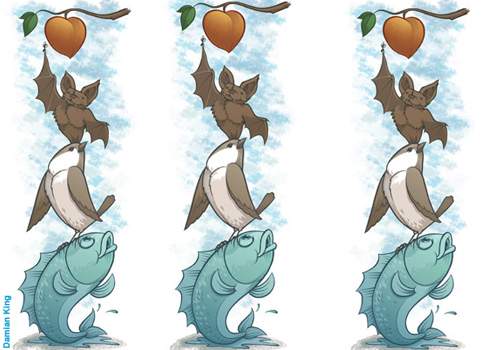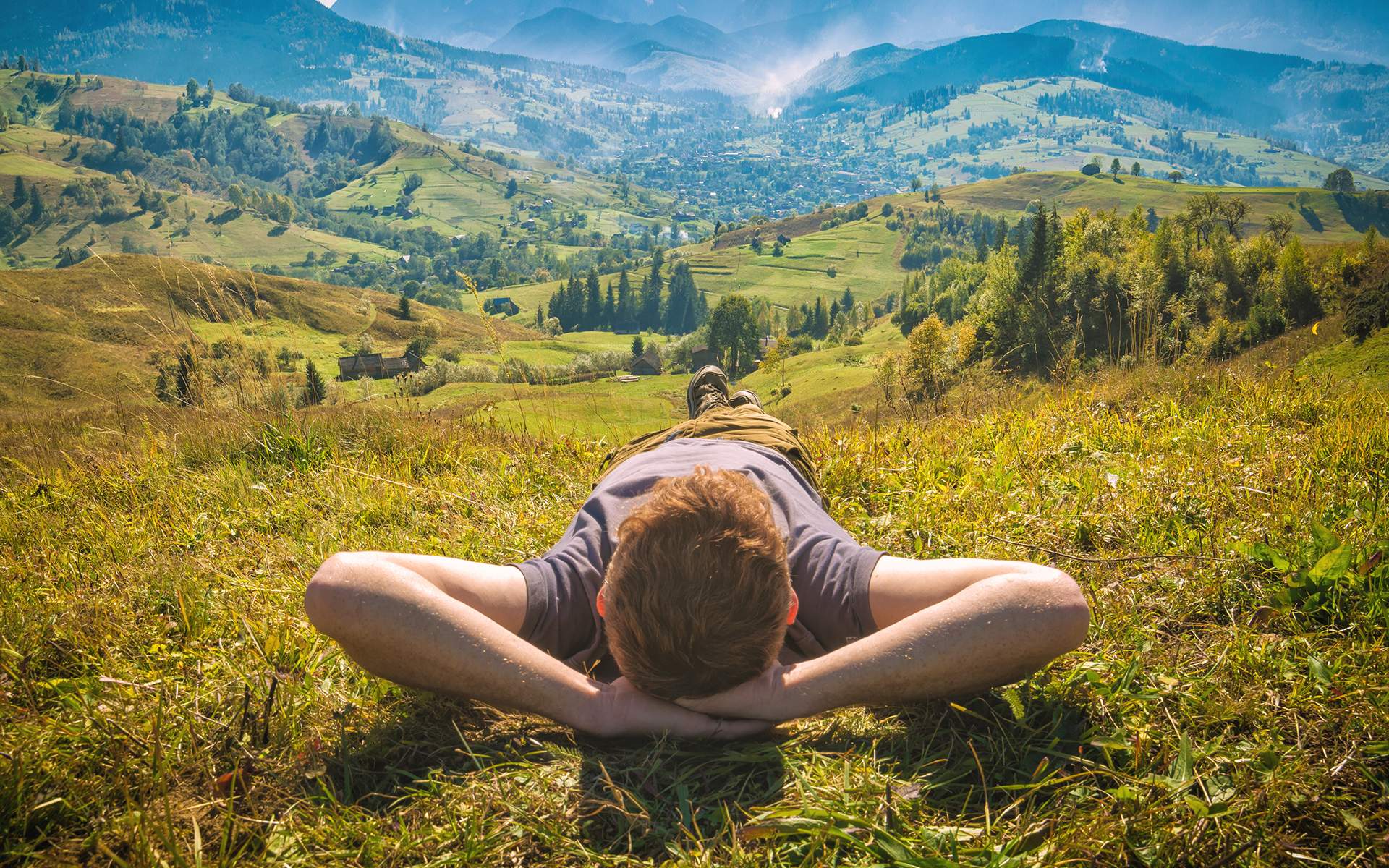By Alex Dixon and Jeremy Adam Smith
Cooperation—where individuals work together in order to create a benefit for an entire group—seems at odds with what many people assume are the basic forces of evolution. After all, it’s a jungle out there, only the strongest survive, humans are selfish, etc.
But most scientists don’t share that view of evolution. “The role of unbridled violence in evolution is greatly overestimated,” says Danny Grunbaum, an oceanographer at the University of Washington and a pioneer in revealing the ways that ocean life cooperates in order to survive. “When we see animals like elephant seals fighting with each other—as we do in lots of nature documentaries—we’re really seeing only a very small sliver of time. Much more of the time they’re accommodating each other and respecting where the boundaries are—and that’s cooperation. There is a tremendous amount of cooperation in nature.”
Across dozens of fields, scientists like Grunbaum are making exciting new discoveries about the nature of cooperation—progress enabled, they say, by new observational and computational technologies. “We are much more able to, for example, take video of a large collection of organisms and quantify their movements using a computer,” says Grunbaum. “Twenty years ago, we would have had to do that by hand, which is agonizing.”
This has resulted in a small but vibrant renaissance in the science of cooperation, which reveals that cooperation is not unique to humans. It’s not even unique to animals. Cooperation is part of nature, down to the cellular level. The reason why is simple, according to evolutionary biologists: Cooperation is one of the most important and beneficial behaviors on Earth. We literally would not be here without it.
Humans, plants, and animals are made up of cells that learned to cooperate long ago. Together they formed multicellular organisms, increasing each individual cell’s chances of replication and survival in the process.
From these biological blocks, cooperation prevails at every level of the animal kingdom. Ants that march to the same drummer move faster. Fish rid other fish of harmful bacteria for a free meal. Small birds protect each other from predators. Bats that share food survive.
In the following tour of the animal kingdom, we can see these and other examples of animals cooperating—and discover the underlying principles that can help humans embrace and improve upon their own cooperative instincts.
Ants
If and when you’re looking for it, you will never see an ant stuck in traffic.
Iain Couzin, a mathematical biologist at the University of Oxford, has spent years studying army ants and other swarming animals—like birds, fish, and locusts—that seem controlled by a single brain. Using video analysis to track the movement of ants on trails (and computer models of individual ants following a trail of pheromones), Couzin and colleagues have identified a few simple rules of ant group behavior—and they’ve laid the foundation for a computer simulation of army-ant highways.
These simulations show that ants have evolved a three-lane, two-way traffic system : As many as 200,000 ants a day pour out of their nest in search of food, splitting into two groups to form two outgoing lanes; they return in a single center lane, sometimes carrying more than 30,000 edible grasshoppers or other insects. Couzin theorizes that the ultra-cooperative ability of these simplistic organisms arises from living in large groups for millions of years.
Research like his has profound implications for robotics and transportation technologies. Roboticists at MIT’s Artificial Intelligence Laboratory cite ant cooperation as inspiration for their robot designs, including those for extraterrestrial probes; a team at the University of Granada in Spain developed a new computer programming language based on an algorithm of ant cooperation; and another team at Haifa Labs in Israel used computer models of ants to program simple robots to cooperate to clean a dirty floor. Ricardo Morla, a professor of engineering at Portugal’s University of Porto, envisions using ants as a model for robot-controlled roadways. The catch is that our cars will be cooperating for us, communicating with street signs and other cars in order to curb traffic—and road rage, an affliction from which ants don’t seem to suffer.
Fish
Among fish, cooperation is motivated by a simple trade off: food for cleanliness. “Cleaner” fish swim into the mouths of the bigger fish—called “clients”—in order to eat parasites and harmful bacteria. The cleaners get a meal, and the clients get a healthier mouth.
Inside the mouths of non-predator clients, however, cleaners will sometimes eat mucus or scales, a meal cleaners seem to prefer over bacteria. Researchers Redouan Bshary of Germany’s Max Planck Institute and Alexandra Grutter of Australia’s University of Queensland call this activity “cheating”: not only do the cleaners eschew bacteria for a tastier meal, but they cause their clients to jolt in pain.
Following that jolt of pain, some non-predatory clients try to punish cheating cleaners by aggressively chasing them. This act of punishment hurts both parties: The client expends energy chasing the cleaner, and the cleaner expends energy being chased. But in interactions immediately following aggressive chasing, researchers observed fewer jolts in client fish. The cleaners seemed to get the message.
In their relationship with predators that could eat them with one swift chomp, cleaners appear to cooperate all the time; to date, no one has observed a predator jolting with a cleaner in its mouth. It would appear that the cost of cheating (certain death) outweigh its benefits (a bit of mucus and some scales).
Why don’t predators eat cleaners? Cleaners are small, hardly a satisfying meal, and a good, trustworthy cleaner takes work to find. Once they’ve established trust between them, predators want to keep their cleaners around.
Birds
When a predator enters the area of a sparrow-like bird called the pied flycatcher, the flycatcher will alert others by screeching loudly. It’s a risky and costly move—screeching draws the predator’s attention.
However, risks can have their benefits. In this case, when other flycatchers hear the call, they “mob” together around the predator, chasing it away. The more birds that join the mob, the more likely the predator will flee, and the quicker the flycatchers can return to their business.
A study conducted by researchers at the University of Daugavpils in Latvia and the University of Tartu in Estonia found that flycatchers engage in tit-for-tat behavior. They only answer the battle calls of birds that have come to fight for them in the past. They don’t answer the calls of birds that heard their call but ignored it.
Bats
For some animals, cooperation seems absolutely essential.
Biologist Gerald Wilkinson at the University of Maryland has shown that groups of vampire bats have a system of food sharing that helps ensure their survival as a species. Bats die if they go two nights without a meal, and hunting for blood—their only source of food—is a risky business. Adult bats fail to find blood eight percent of the time. Younger bats fail one night out of every three.
But hunger is rare because bats that find blood share it with bats that don’t. But they do this only as long as the favor is someday returned. If a colony didn’t share food, four out of every five bats would die each year. But by cooperating, the death rate is slashed to one in four.
Of course, “cheaters,” those who receive blood but never share it, can reap the benefits of cooperation (free food) without paying (hunting and sharing when someone else is hungry). But like the feedback rating on eBay that helps identify dishonest users, reputation plays an important role in the bats’ food-sharing system. Bats that cheat will eventually build up a reputation for doing so, and others will stop sharing with them. In the long run, cheating isn’t profitable—something that research suggests is also true in human society.
Humans
Most human beings don’t share food that directly—at least not any more—but we do cooperate in plenty of ways, from writing Wikipedia articles to forming lines for the bathroom. Still, as is clear to anyone who’s ever been stuck in rush-hour traffic or tried to do some last minute Christmas shopping, human cooperation can break down, sometimes suddenly.
To foster cooperative success in human organizations, some scientist-philosophers believe that we should look to nature for inspiration. “Nature nurtures life through communities,” says physicist and best-selling author Fritjof Capra. “This is a process that started with the first single-celled organisms. Life, from its beginning more than three billion years ago, took over the planet by networking, not combat.” To Capra, this calls for cooperative social organization that nurtures networks of communication, encourages sharing and experimentation, and fosters a climate of mutual support.
This doesn’t mean that cooperation eliminates conflict. “Cooperation never means the absence of conflict of interest,” notes oceanographer Danny Grunbaum. “It means a set of rules for negotiating conflicts of interest in a way that resolves them.” In the 21st century, argue both Grunbaum and Capra, learning to cooperate is more critical than ever before in human history. “That’s in part because our society is becoming so much more integrated and communication is happening much more quickly all over the world,” says Grunbaum.
Grunbaum suggests looking to science as an example of a human community in which cooperation works. “Cooperation in general is a very good strategy in science,” he says. “It’s exceedingly rare for someone to take advantage of you if you chose to share your work in an unguarded way. I’d say that human beings are extraordinarily cooperative, and we’re getting more cooperative all the time.”
Alex Dixon is a Greater Good editorial assistant. Jeremy Adam Smith is editor of the Greater Good website and author of the book The Daddy Shift.
To read more articles on cooperation research, visit our Survival of the Kindest page.
This article originally appeared on Greater Good, the online magazine of UC Berkeley’s Greater Good Science Center, one of Mindful’s partners. To view the original article, click here.
This web extra provides additional information related to an article titled, “Kindness Evolution,” which appeared in the August 2013 issue of Mindful magazine.






